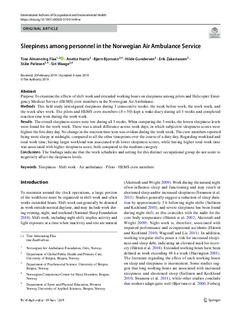| dc.contributor.author | Flaa, Tine Almenning | |
| dc.contributor.author | Harris, Anette | |
| dc.contributor.author | Bjorvatn, Bjørn | |
| dc.contributor.author | Gundersen, Hilde | |
| dc.contributor.author | Zakariassen, Erik | |
| dc.contributor.author | Pallesen, Ståle | |
| dc.contributor.author | Waage, Siri | |
| dc.coverage.spatial | Norway | nb_NO |
| dc.date.accessioned | 2019-08-30T07:06:12Z | |
| dc.date.available | 2019-08-30T07:06:12Z | |
| dc.date.created | 2019-07-30T13:49:41Z | |
| dc.date.issued | 2019 | |
| dc.identifier.citation | Flaa, T. A., Harris, A., Bjorvatn, B., Gundersen, H., Zakariassen, E., Pallesen, S., & Waage, S. (2019). Sleepiness among personnel in the Norwegian Air Ambulance Service. International Archives of Occupational and Environmental Health. | nb_NO |
| dc.identifier.issn | 0340-0131 | |
| dc.identifier.uri | http://hdl.handle.net/11250/2611704 | |
| dc.description.abstract | Purpose To examine the effects of shift work and extended working hours on sleepiness among pilots and Helicopter Emergency Medical Service (HEMS) crew members in the Norwegian Air Ambulance.
Methods
This field study investigated sleepiness during 3 consecutive weeks: the week before work, the work week, and the week after work. The pilots and HEMS crew members (N = 50) kept a wake diary during all 3 weeks and completed reaction time tests during the work week.
Results
The overall sleepiness scores were low during all 3 weeks. When comparing the 3 weeks, the lowest sleepiness levels were found for the work week. There was a small difference across work days, in which subjective sleepiness scores were highest the first duty day. No change in the reaction time tests was evident during the work week. The crew members reported being most sleepy at midnight, compared to all the other timepoints over the course of a duty day. Regarding workload and total work time, having larger workload was associated with lower sleepiness scores, while having higher total work time was associated with higher sleepiness score, both compared to the medium category.
Conclusions
The findings indicate that the work schedules and setting for this distinct occupational group do not seem to negatively affect the sleepiness levels. | nb_NO |
| dc.language.iso | eng | nb_NO |
| dc.publisher | Springer | nb_NO |
| dc.rights | Navngivelse 4.0 Internasjonal | * |
| dc.rights.uri | http://creativecommons.org/licenses/by/4.0/deed.no | * |
| dc.subject | sleepiness | nb_NO |
| dc.subject | shift work | nb_NO |
| dc.subject | air ambulance | nb_NO |
| dc.subject | pilots | nb_NO |
| dc.subject | HEMS crew members | nb_NO |
| dc.title | Sleepiness among personnel in the Norwegian Air Ambulance Service | nb_NO |
| dc.type | Journal article | nb_NO |
| dc.type | Peer reviewed | nb_NO |
| dc.description.version | publishedVersion | nb_NO |
| dc.rights.holder | © The Author(s) 2019. | nb_NO |
| dc.subject.nsi | VDP::Medisinske Fag: 700::Helsefag: 800 | nb_NO |
| dc.source.pagenumber | 1-10 | nb_NO |
| dc.source.journal | International Archives of Occupational and Environmental Health | nb_NO |
| dc.identifier.doi | 10.1007/s00420-019-01449-w | |
| dc.identifier.cristin | 1713244 | |
| cristin.unitcode | 203,10,1,0 | |
| cristin.unitname | Institutt for idrett, kosthald og naturfag | |
| cristin.ispublished | true | |
| cristin.fulltext | original | |
| cristin.qualitycode | 1 | |

